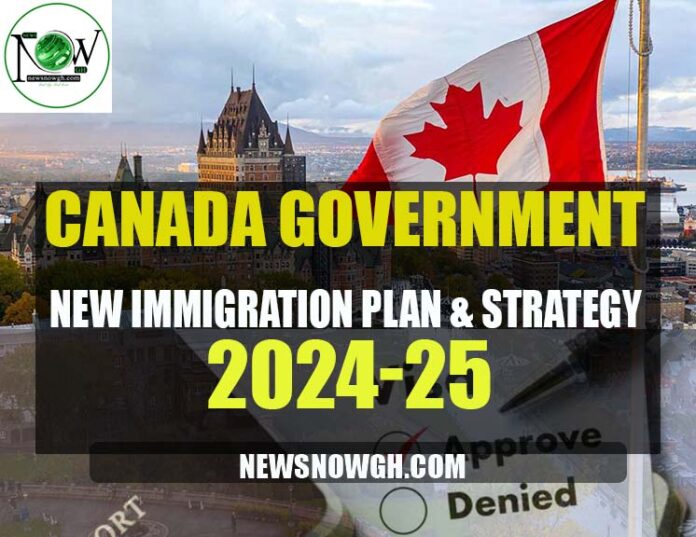Canada Government New Immigration Plan & Strategy 2024–25
Canada stands out as a beacon of opportunity and variety in the ever-changing global scene, drawing immigrants from all over the world. Immigration, Refugees, and Citizenship Canada have developed a comprehensive plan targeted at bolstering the country’s immigration and settlement institutions to guarantee its ongoing success and prosperity.
This approach, which is based on ideas of efficiency and inclusivity, aims to address important issues such as integration obstacles, uneven job outcomes, and processing delays. Through the implementation of the IRCC’s future vision, Canada hopes to create an immigrant-friendly and resilient society.
Strengthening Canada’s Immigration Landscape
Implementing IRCC’s Vision for the Future
Canada has become a global leader in immigration and settlement practices in recent years, drawing people from a wide range of origins and enhancing the economic and cultural vibrancy of the nation. Notwithstanding its achievements, the immigration system has faced some obstacles, such as protracted processing times, uneven job opportunities, and hindrances to assimilation.
Immigration, Refugees and Citizenship Canada (IRCC) has created a comprehensive strategy to improve the efficacy and efficiency of the immigration and settlement processes to solve these problems. This approach acknowledges the complex interplay between a variety of factors, including housing, healthcare, and work possibilities, which shape the experiences and results of immigrants.
The need for strong leadership and centralized coordination
Strong, centralized leadership is essential to the immigration policy of the International Republican Committee (IRCC), as is efficient collaboration among stakeholders. A pan-Canadian strategy is necessary due to the intricate and intersecting nature of immigration laws, necessitating cooperation and coordination at all governmental levels as well as within Civil Society.
World Education Services (WES) has recommended, among other things, that the Prime Minister’s office develop clear governance under the leadership of the Privy Council. This centralized authority would be in charge of directing the strategy’s execution, establishing goals and deadlines, and making sure that accountability and enforcement systems are in place.
Furthermore, WES highlights the significance of collaborating with local regulators to simplify registration procedures and regulated professions, thereby promoting more seamless absorption into the Canadian workforce.
Building Capacity for Effective Implementation
Clarity in the processes and systems for consultation, coordination, and accountability is essential to the effective implementation of IRCC’s immigration strategy. This entails establishing defined roles and responsibilities for each stakeholder, putting in place strong monitoring and evaluation systems, and setting challenging but doable deadlines for important projects.
To guarantee that the opinions of immigrants, settlement organizations, employers, and other pertinent players are heard throughout the implementation process, the IRCC must also create a structure for stakeholder engagement. This collaborative method not only increases purchasing and support but also makes it possible to spot new problems and areas that could use development.
Promoting Regional Alignment and Collaboration
The IRCC’s approach highlights the value of regional cooperation and alignment in addition to strong central control, especially through the Provincial Nominee Program (PNP). The IRCC seeks to encourage long-term settlement and integration across Canada, address local labor market needs, and promote regional economic development through close collaboration with provinces and territories.
To do this, the federal government should work to lower immigrant job obstacles by attempting to standardize registration procedures in regulated occupations across provinces. This can be achieved through improved coordination between federal and local regulatory agencies, the development of uniform licensing requirements, and reciprocal recognition of qualifications.
Conclusion: Charting a Path Forward
The long-term economic and social cohesiveness of Canada depends on the effective execution of the IRCC’s immigration strategy, as the nation continues to develop as a top immigration destination internationally. Strong leadership, centralized coordination, and stakeholder involvement should be given top priority to create an immigration system that is more sensitive to the requirements of newcomers and supports the continuous success of Canada.
Employing cooperation and alliances, Canada might sustainably enhance its standing as a worldwide frontrunner in immigration and settlement regulations, contributing to the enhancement of its social structure and propelling economic expansion for an extended period. The adoption of the IRCC’s immigration plan is a critical step in creating a better future for everyone as Canada navigates its future.
Strong leadership, centralized coordination, and stakeholder involvement are key components that Canada can use to create a more adaptable and inclusive immigration system that aligns with the country’s ideals of opportunity and diversity. Employing joint endeavor and dedication, Canada will persistently fortify its standing as a worldwide frontrunner in immigration and settling practices, enhancing the quality of life for both immigrants and Canadians for many years to come.
Follow us on Newsnowgh.com to stay updated on the latest information regarding work permits, visa application processes, paths to permanent residency, and visa-sponsored employment.


